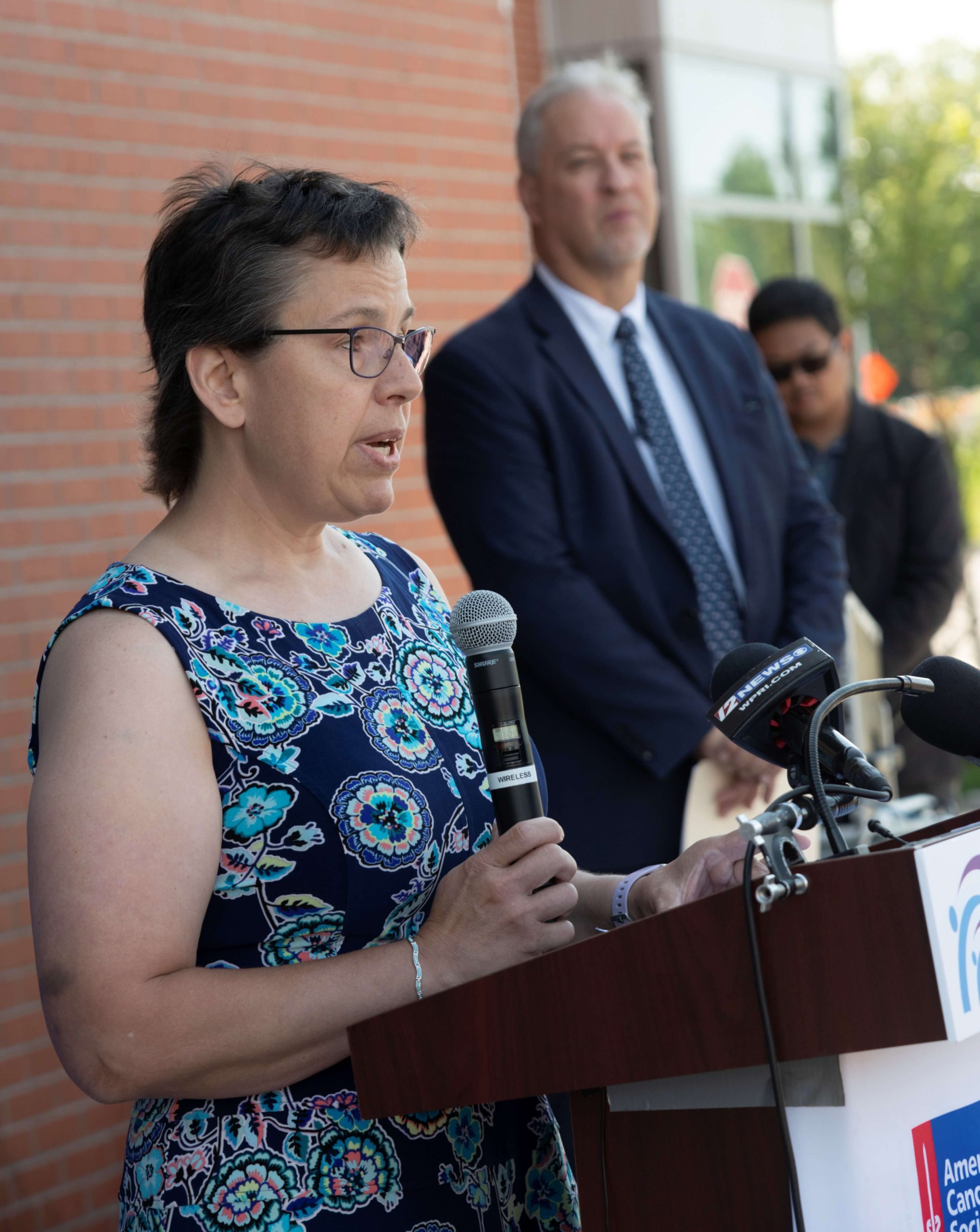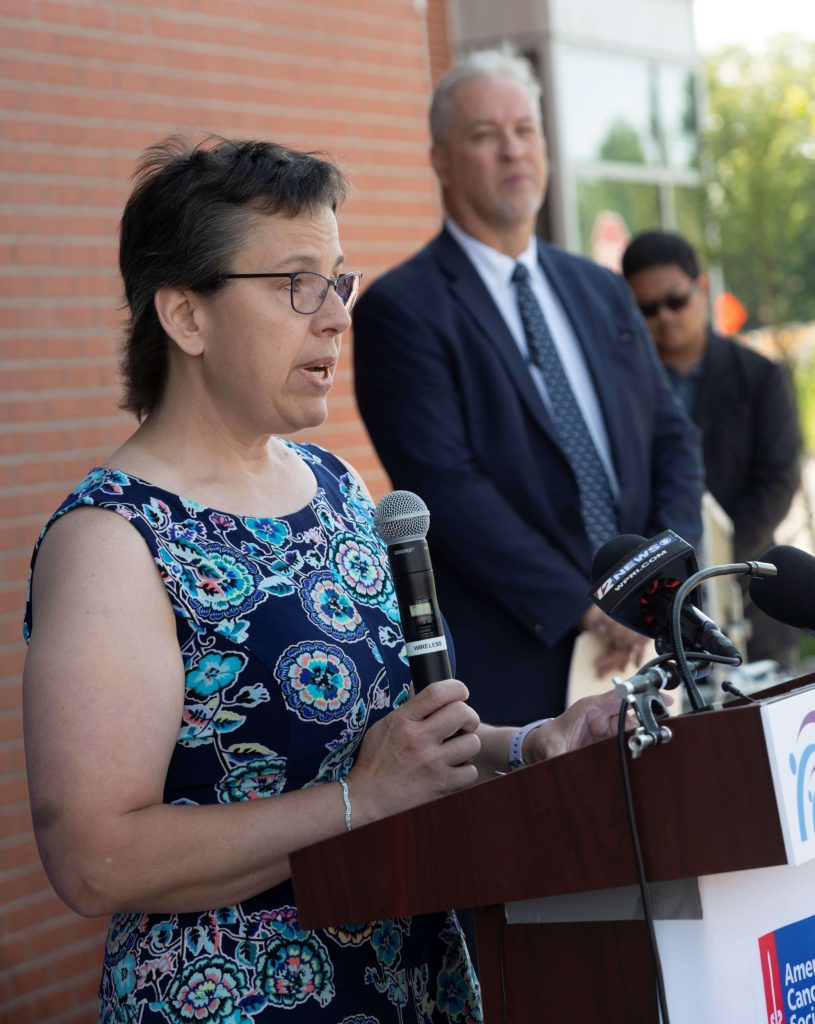At the press conference announcing a $20,000 Crucial Catch grant to Providence Community Health Centers, Rachel DeBonis, BSN, RN, shared her story of breast cancer screening, diagnosis, treatment, and advocacy. Rachel, a nurse at our Asthma and Allergy Clinic, was one of the speakers at the event, which detailed a grant awarded by The American Cancer Society, New England Patriots Foundation, and National Football League to safely increase breast cancer screening in our community.
The following are Rachel’s remarks from that day. Please read and act on her message: screening saves lives!

My Story: Breast Cancer Awareness & Importance of Early Detection
by Rachel DeBonis, BSN, RN
I became an LPN in 2001 and in 2004, I received my Associate Degree in Nursing. In my career, I have worked in a variety of hospital settings including oncology, medical/surgical, and labor and delivery. In December 2012, I joined the Providence Community Health Centers (PCHC), Rhode Island’s largest health center network that serves more than 60,000 patients. I am both an employee of PCHC and a patient.
As I no longer had to work nights, weekends, or holidays, I reenlisted in the National Guard four years ago and decided it was time to complete my bachelor’s degree. In January 2021, I was in my last semester and needed to choose a healthcare topic I felt passionately about for my final capstone paper.
I needed to write a paper on creating change. For my topic, I chose the importance of mammograms and the need for people to return to health screenings despite a global pandemic. Due to COVID-19, there had been gaps in screenings in every health care organization for a variety of reasons including the lack of in-person appointments and patient’s fears of leaving home for scheduled visits.
In my research, I learned that an estimated 43,000 women in the United States were expected to die from breast cancer in 2021 and that breast cancer screening rates remain consistently lower among minority populations compared to that of Non-Hispanic Whites.
My last mammogram had been in July 2019. I was overdue and because of my topic, I made an appointment to be screened. The first available appointment was April 22, 2022, which I booked.
While waiting the eight weeks until my appointment, I focused on my project. I had a huge list of overdue eligible patients for the provider I worked with and called them by phone. If I couldn’t reach them, I mailed letters along with educational information (in English and Spanish) on the mammography process and how safe and important it was.
When breast cancer is identified early, there is a greater survival rate; identifying barriers to care and educating patients on how to overcome this is both challenging and rewarding. Approximately six months later, I learned my efforts at outreach had paid off and my team had a very high mammography screening rate.
The week of my mammogram appointment was my first week working with a new provider in our Allergy and Asthma specialty clinic. Much of what I am sharing next comes directly from a diary I kept.
April 22: I arrive early to the Anne Pappas Center for Breast Imaging at Rhode Island Hospital in hopes that I will be seen early and not be too late for work. I arrive to work only one hour late.
At 11 a.m. the same day, I receive an email through the patient portal that my mammo results are in. My mammo is abnormal. First time in the past seven screenings I have seen this. What is a spiculated mass? I Google it.
A spiculated mass is a lump of tissue with spikes or points on the surface. It is suggestive but NOT diagnostic of malignancy. At noon, I call Anne Pappas to schedule an appointment for more imaging of my right breast, as suggested. I am able to make an appointment for the following week. The wait to know if I have cancer is excruciating.
The day finally arrives, and my ultrasound shows a mass that needs to be biopsied. Dr. Emily White, my OB-GYN at PCHC, faxes the order to have my mass biopsied that same day. There is NO family history of breast cancer, so I am hoping for the best.
The radiologist who performs the biopsy is honest with me and states it is most likely cancer. The biopsy will tell me which type. I will find that out in 2-5 business days. In the meantime, I meet with a patient care coordinator to pick out a breast surgeon and discuss the “next steps.”
April 30: Just two days later, I am discussing my biopsy results with the surgeon I had chosen. She is able to confirm that I have triple negative breast cancer and will need chemo. Next, I will need genetic testing and a breast MRI to make sure the ultrasound was accurate for size. The same day at 11 a.m., Dr. White calls me on the phone to check how I am doing. I tell her “So far, so good… just so much to process.” At 3 p.m., the surgeon’s office calls to tell me genetics will be contacting me via video call on May 6th and then I will have the MRI on May 9th, which also happened to be Mother’s Day.
Everything is happening so fast and I am feeling a bit overwhelmed. Depending on genetics results, I will know if I have a high probability of getting another breast cancer in the future. If that is the case, I will opt for a complete mastectomy.
May 10: It is the day after my MRI. I go to the hospital to have the genetic bloodwork done. Those results will be due in a week or so. At 2:45 p.m. of same day, I get a bit of good news. According to the MRI, the cancer is still just in my right breast, hasn’t grown much, and it did not appear as though it has yet spread to my nearby lymph nodes.
May 11: My husband and I meet with my cancer team. I am told there are very limited chemo therapies that work for triple negative breast cancer. I will start losing my hair after the second treatment. When I was told this, I start crying, not because I am vain, but because I cannot hide my diagnosis from anyone once that happens.
May 14: I speak with an RN from oncology for a TEACH. I will be receiving four rounds of Adriamycin every two weeks with a Neulasta shot one day post-treatment to boost my blood counts. Then two weeks after that chemotherapy ends, I will start Taxol for 12 weekly sessions. I also must get CBC bloodwork completed at least one day prior to every scheduled treatment. If I have bone pain, I can take Claritin. Mouth sores and constipation are very common side effects and everyone experiences neuropathy which is numbness, tingling, muscle weakness and pain. Sometimes it’s permanent. TOO MUCH INFORMATION! I am numb.
May 20: It is 10 days since my genetic testing. I get the news that my BRCA genes 1 & 2 are negative, which means my daughters should not inherit this. I will not be needing a complete mastectomy. The thing I learned about triple negative breast cancer is, if it reappears, it is more likely to return to another part of your body.
May 21: Had my cardiac echo today to determine if my heart is strong enough for chemo.
May 26: After going to nuclear medicine yesterday to have a dye injected within my breast area to “light up” my sentinel lymph node within right armpit for removal and testing, I am back at the hospital to have my tumor and lymph node removed. The next day my armpit is very sore.
June 8: Met with team today and had the steri strips removed from my armpit and breast. All looks well. Port placement scheduled for next week and my college graduation is in four days. So much has happened since choosing my research topic in January.
June 18: My port is placed for chemo access. It feels a bit itchy and uncomfortable, but I am sure I will get used to it.
June 23: I will work until 1 p.m. today because my first chemo is at 1:30 p.m.. I am feeling nervous…. How will I react to chemo? I hate not knowing.
Last journal entry.
June 25: Two days have passed since my first chemo session. Accessing the port didn’t hurt too much and the process took approximately 3 hours. I am just a bit tired.
I continued to be tired so I would work about 25 hours a week until treatments were over. Throughout my treatment, I would post weekly updates on social media urging my friends and family to get screened and to have them urge their family members and friends to go for screenings. I would be told later that I inspired approximately 1/3 of my eligible friend and family group… so, every dark cloud DOES have a silver lining.
November 3rd was my final chemo treatment. Two weeks later, I began my radiation. I received five treatments a week, ending December 28th. My goal was to start 2022 treatment and cancer-free. I succeeded.
………………………………
I would like to take this opportunity to thank everyone who was so kind and supportive while I was going through treatments starting with my husband and our six children who stepped up and helped more at home. The prayers I received from my church, friends, family, and co-workers meant a lot to me and gave me strength. I am so fortunate to have gone through this ordeal and be where I am today. The follow-up scans that I have had within the past two months have shown no evidence of cancer.
Without getting that mammography when I did, the aggressive cancer I had would have spread to my lymph nodes. I don’t even want to think about how that would have changed this past year and my future. I feel honored to be able to speak for all the women who have gone through this battle, who are currently fighting this disease, and for those who have gone before us and are no longer here. You are all warriors!
The MOST important factor that determines prognosis in breast cancer is early diagnosis. Please, GO GET SCREENED!

